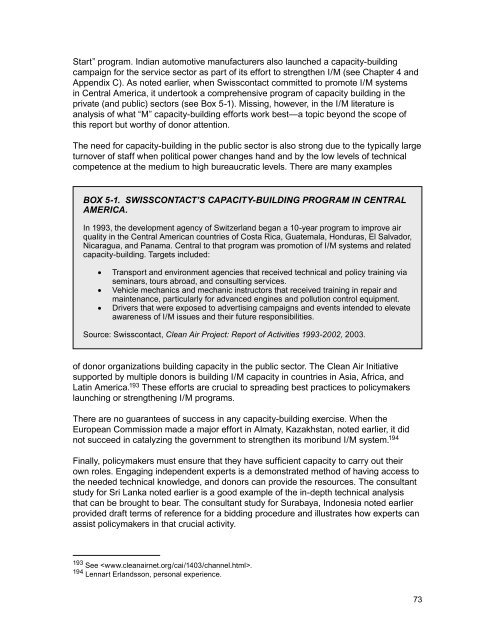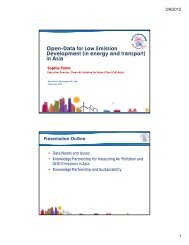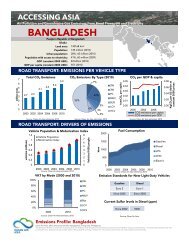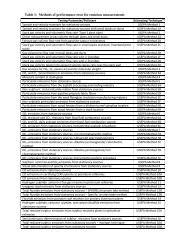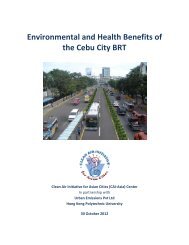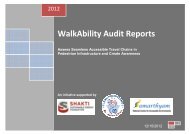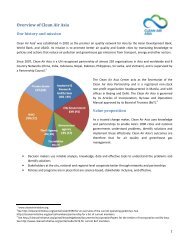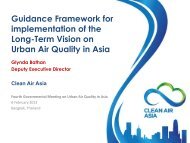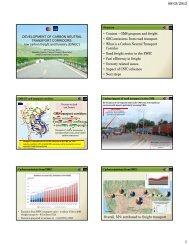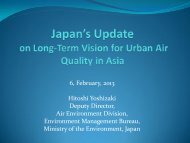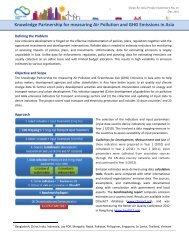International Experience and Best Practices - Clean Air Initiative
International Experience and Best Practices - Clean Air Initiative
International Experience and Best Practices - Clean Air Initiative
Create successful ePaper yourself
Turn your PDF publications into a flip-book with our unique Google optimized e-Paper software.
Start” program. Indian automotive manufacturers also launched a capacity-building<br />
campaign for the service sector as part of its effort to strengthen I/M (see Chapter 4 <strong>and</strong><br />
Appendix C). As noted earlier, when Swisscontact committed to promote I/M systems<br />
in Central America, it undertook a comprehensive program of capacity building in the<br />
private (<strong>and</strong> public) sectors (see Box 5-1). Missing, however, in the I/M literature is<br />
analysis of what “M” capacity-building efforts work best—a topic beyond the scope of<br />
this report but worthy of donor attention.<br />
The need for capacity-building in the public sector is also strong due to the typically large<br />
turnover of staff when political power changes h<strong>and</strong> <strong>and</strong> by the low levels of technical<br />
competence at the medium to high bureaucratic levels. There are many examples<br />
BOX 5-1. SWISSCONTACT’S CAPACITY-BUILDING PROGRAM IN CENTRAL<br />
AMERICA.<br />
In 1993, the development agency of Switzerl<strong>and</strong> began a 10-year program to improve air<br />
quality in the Central American countries of Costa Rica, Guatemala, Honduras, El Salvador,<br />
Nicaragua, <strong>and</strong> Panama. Central to that program was promotion of I/M systems <strong>and</strong> related<br />
capacity-building. Targets included:<br />
• Transport <strong>and</strong> environment agencies that received technical <strong>and</strong> policy training via<br />
seminars, tours abroad, <strong>and</strong> consulting services.<br />
• Vehicle mechanics <strong>and</strong> mechanic instructors that received training in repair <strong>and</strong><br />
maintenance, particularly for advanced engines <strong>and</strong> pollution control equipment.<br />
• Drivers that were exposed to advertising campaigns <strong>and</strong> events intended to elevate<br />
awareness of I/M issues <strong>and</strong> their future responsibilities.<br />
Source: Swisscontact, <strong>Clean</strong> <strong>Air</strong> Project: Report of Activities 1993-2002, 2003.<br />
of donor organizations building capacity in the public sector. The <strong>Clean</strong> <strong>Air</strong> <strong>Initiative</strong><br />
supported by multiple donors is building I/M capacity in countries in Asia, Africa, <strong>and</strong><br />
Latin America. 193 These efforts are crucial to spreading best practices to policymakers<br />
launching or strengthening I/M programs.<br />
There are no guarantees of success in any capacity-building exercise. When the<br />
European Commission made a major effort in Almaty, Kazakhstan, noted earlier, it did<br />
not succeed in catalyzing the government to strengthen its moribund I/M system. 194<br />
Finally, policymakers must ensure that they have sufficient capacity to carry out their<br />
own roles. Engaging independent experts is a demonstrated method of having access to<br />
the needed technical knowledge, <strong>and</strong> donors can provide the resources. The consultant<br />
study for Sri Lanka noted earlier is a good example of the in-depth technical analysis<br />
that can be brought to bear. The consultant study for Surabaya, Indonesia noted earlier<br />
provided draft terms of reference for a bidding procedure <strong>and</strong> illustrates how experts can<br />
assist policymakers in that crucial activity.<br />
193 See .<br />
194 Lennart Erl<strong>and</strong>sson, personal experience.<br />
73


